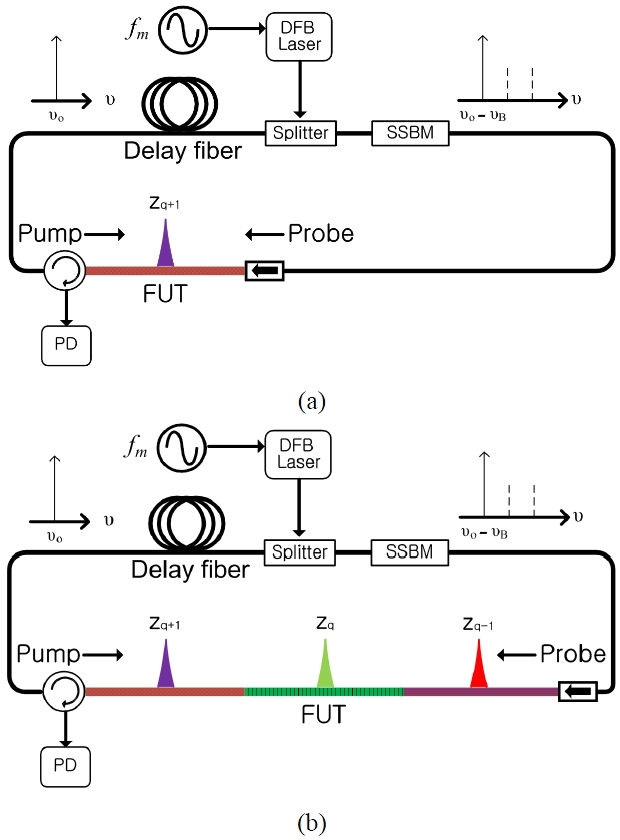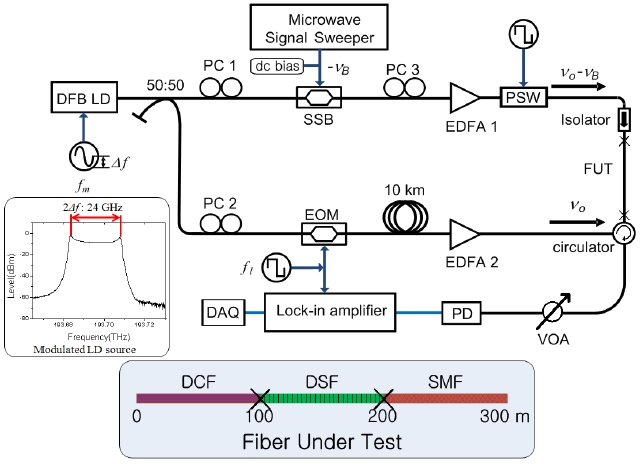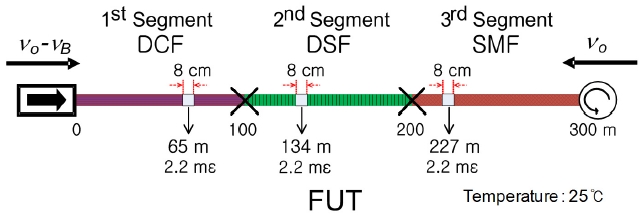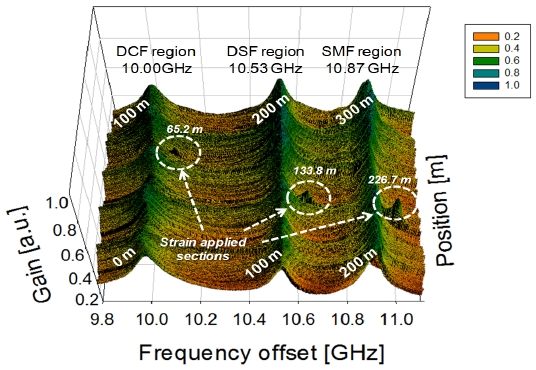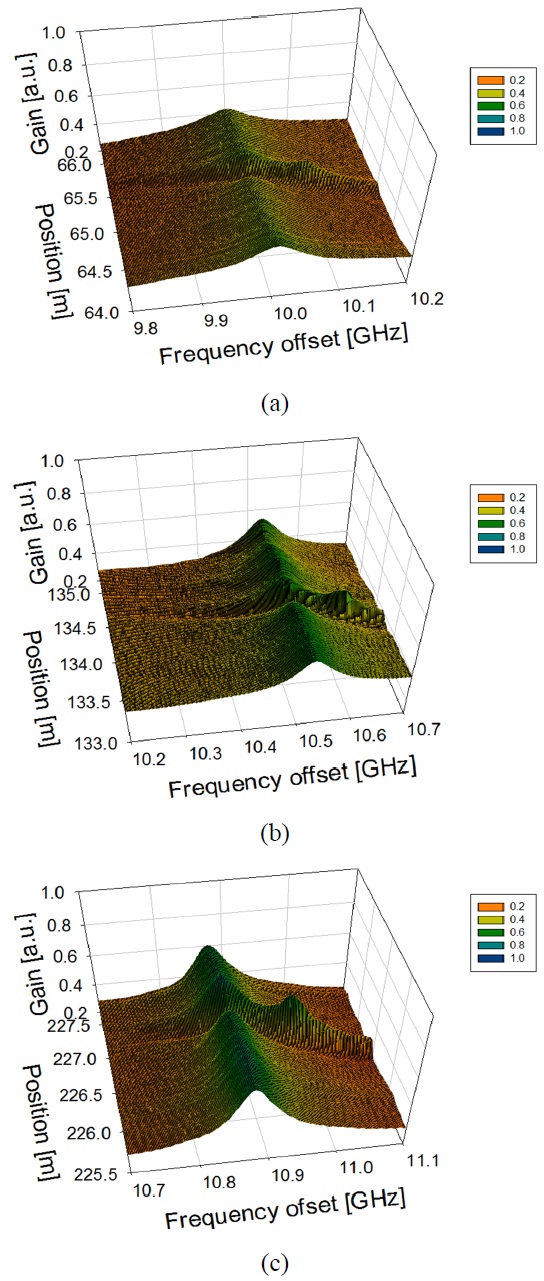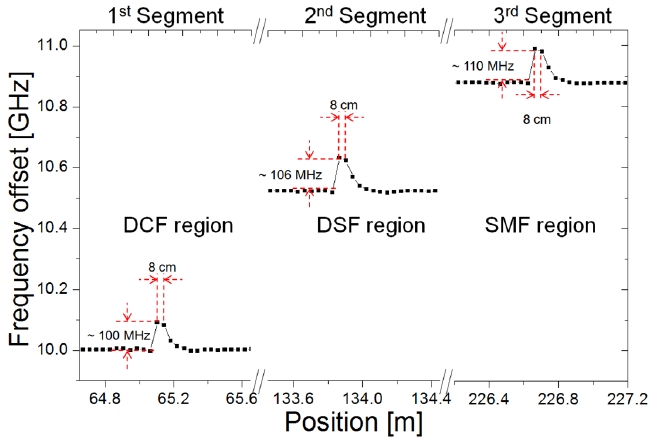



So far, Brillouin scattering based sensors have been studied as promising technology for a distributed temperature or strain measurement in structural health monitoring [1-10]. Intrinsically, Brillouin scattering is an effect caused by acoustic vibrations in the medium when laser light travels in a medium such as an optical fiber. Since the sound wave is traveling, light is also subjected to a Doppler shift, so its frequency changes. The Brillouin frequency shift
On the other hand, in optical fibers, the acoustic velocity depends on the material density
where
Since any temperature variation or deformation experienced by the fiber will also have an impact on its density, the Brillouin frequency will be shifted with the temperature or strain as expressed in Eq. (1) and (2). Also it is known that Brillouin frequency shift (BFS) is linearly proportional to these two quantities [9]:
where
Among many Brillouin scattering based sensors, the most extensively studied techniques are Brillouin optical time domain reflectometry (BOTDR), Brillouin optical time domain analysis (BOTDA), and Brillouin optical correlation domain analysis (BOCDA). BOTDR and BOTDA have an advantage of long measurement range of several tens of km. However, their long measurement time (~ several minutes) and limited spatial resolution (> 50 cm) may prevent some specific applications for health monitoring of structures such as aircraft wings, rockets, and wind turbine blades. Meanwhile, BOCDA has a high spatial resolution (~ cm order) and a high sampling rate (~ kHz) with random access of sensing position. In this system, modulation parameters (amplitude and frequency) of a light source must be chosen such that only a single correlation peak lies within the sensing fiber. Thus, there is a trade-off problem between the spatial resolution and the measurement range [12-14]. Several techniques have been introduced to extend the measurement range while maintaining the spatial resolution such as optical time gating [14] (the measurement range: 250 m, the spatial resolution: 8 cm), double frequency modulation [15] (the measurement range: 34 m, the spatial resolution: 10 cm), and using different kinds of fibers [16]. Particularly, in [16], they demonstrated two times enlargement of strain distribution measurement range by using two different kinds of fibers and a typical electro-optic modulator (EOM) with the measurement range of 8 m and the spatial resolution of 4 cm. In this scheme, it is undesirable for the modulation amplitude
To solve these problems, we use a single sideband (SSB) modulator instead of an EOM. In this scheme,
In the typical BOCDA system, a sinusoidal frequency modulation is applied to the pump and probe waves, producing periodical correlation peaks along the test fiber [3]. The periodic correlation position
where
an integer,
where
where
Accordingly, to increase the measurement range, modulation frequency
III. EXPERIMENTS AND DISCUSSION
The experimental setup is shown in Fig. 2. A FUT was constructed by splicing 100 m-DCF, 100 m-DSF and 100 m-SMF, which have different Brillouin resonance frequencies.
As a light source, 1548 nm-distributed feedback laser diode (DFB-LD) was used, and a sinusoidal frequency modulation was applied to generate two correlation peaks within FUT. The modulation frequency
As a proof of concept experiment, we performed measurement of BGS along the FUT, in which the strain of 2.2 mε was applied to three 8-cm sections and a temperature was maintained by an environment control system at 25℃ as shown in Fig 3. There are three correlation positions within the FUT: One is located in the DCF (0-100 m), another one in the DSF (100-200 m) and the third in the SMF (200-300 m). Since the
The BGS was measured every 4 cm along the FUT, sweeping
are observed in each fiber. Note that the
Fig. 5 shows an expanded view of the distributed BGS of the circled segments shown in Fig. 4.
On the other hand, Fig. 6 shows the distribution of the BFS derived from the data of Fig. 5(a)-(c). The spatial resolution was calculated to be about 8.0 cm by Eq. (7). We can observe clear Brillouin frequency shifts (BFS) at the strain applied sections. The change of the BFS was about 100 MHz, 106 MHz, and 110 MHz for DCF, DSF, and SMF region, respectively, which agree well with the applied strain of 0.22%. Also the BFSs have different slopes of BFS which are 0.046 MHz / 1 με , 0.0484 MHz / 1 με and 0.05 MHz / 1 με for DCF, DSF, and SMF, respectively by Eq. (3). The measurement error was about +/- 3.5 MHz, corresponding to the strain accuracy of +/- 0.007% (+/-70 με ).
Thus, we successfully demonstrated strain distributed measurement over 300-m measurement range with 8.0-cm spatial resolution by using the proposed scheme, which has three times larger measurement range than that of the conventional BOCDA system.
In conclusion, we achieved a factor of 3 expansion of measurement range in BOCDA system by using different kinds of fibers while maintaining the spatial resolution. In this technique, multiple correlation peaks within the sensing section can be utilized since any correlation peak point can be arbitrarily selected due to different Brillouin frequency shifts. In the experiment, by adopting the SSBM and variation -frequency lock-in detection technique, we could get a better spatial resolution. We expect that the proposed BOCDA system could be useful in the strain monitoring of civil structures.
